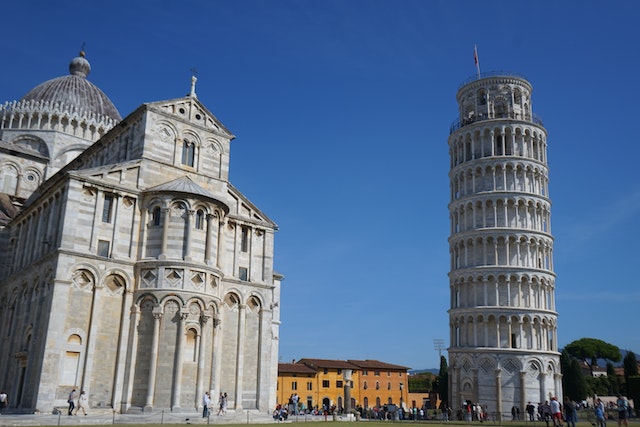
Why does the Leaning Tower of Pisa lean? It leans because the ground under the tower is not hard enough and has settled.
The Leaning Tower of Pisa is 55.86 meters tall, and it leaned by 5.5 degrees off center at its peak. It was stabilized in the 1990s and its lean was reduced to 3.97 degrees. Not all of the tower leans. The first three floors lean the most. Then the next four floors lean slightly less and the bell tower at the top was built later and is almost straight.
The tower is the bell tower for Pisa Cathedral. The cathedral was built in 1063 and in 1173 the first stones of the bell tower were laid. The architect had designed an 8 story, white marble bell tower. The architect’s name is unknown, perhaps because they didn’t want to be associated with the tower. It is thought that the architect was Diotisalvi, an architect active in the area at the time, although there is no proof. It is in a similar style to other buildings he made, so the chances are good it was him.
The plans called for a three-meter foundation and the first stones were laid on 9th August, 1173. By the start of 1178, the builders had managed to reach the third floor, when building work was abandoned. It was probably abandoned because of military action as the work had to be fitted around the various wars that were ongoing at the time. When work was set to resume on the tower, it was discovered that it had begun to tilt alarmingly. There were two problems. The first problem was that a three-meter foundation is not deep enough to support a building of eight stories. The second problem was the type of soil the tower was built on. Romans usually made their foundations by burying huge stone pillars in the ground, on top of the bedrock. This provided the strength and the stability that they needed. The trouble with Pisa is that the bedrock is really deep. A bore sample taken in the 1950s showed that the ground is made up of regular soil, then sandy silt, then clay and sand, then more sand, then more clay, and then more sand, down to a depth of 50 meters. There is no rock. And all of these materials are not solid. It also turned out that the soil on the south side of the tower had more silt, sand, and clay than on the north side. When the builders reached the third floor, the weight was too great for the soil to support and the south side started to sink, giving the tower its lean.
When building work resumed in 1272, the 100-year gap had given the soil time to settle, and the tower was stable. If they had been able to build all eight floors in 1173, the tower would have undoubtedly collapsed. In 1272, they decided to try and correct the lean by building the upper floors at an angle to the first three floors. This is why the tower is curved. They also tried to counter the tilt by building the tower with thicker stones on the northern side. They cut larger marble blocks and made it thicker and slightly taller. They hoped that the extra weight on that side would pull the tower back into alignment. They reached the seventh floor in 1278 and had to stop work again because of another war. Their plan hadn’t worked because the extra weight of the tower had made it lean even more than before and it was at a real risk of collapsing.
In 1360, they were able to build again, and they added the bell tower at the top. They also built this at an angle to the rest of the tower, making it banana shaped. The weight was too much, and the tower continued to lean. The lean increased ever so slightly year by year until it peaked in the 1980s. A large factor in the tilt was caused in 1838 when a walkway called the catino was built around the tower. In an effort to show visitors the foundations of the tower, the soil was dug away to reveal them. This raised the water table and reduced the stability of the tower, increasing the lean.
It was only in the 1990s that the lean was halted. The first solution was to counterbalance the tower with 900 tons of lead weights. This worked, but it wasn’t very aesthetic, so the next solution was to remove some of the soil from under the northern side of the tower. The tower had to be secured with cables before work could begin and it took almost ten years, but enough soil was removed to reduce the lean of the tower by 2 degrees, to the current 3.97, and to stabilize it. Today, the Leaning Tower of Pisa is leaning, but the lean is not changing much. Predictions are that it will probably be ok for the next 200 years before soil extraction needs to be performed again. And this is what I learned today.
Photo by Supakakul Sanguansuk: https://www.pexels.com/photo/the-pisa-cathedral-and-the-leaning-tower-of-pisa-13321750/
Sources
https://en.wikipedia.org/wiki/Leaning_Tower_of_Pisa
https://www.history.com/news/why-does-the-leaning-tower-of-pisa-lean
https://leaningtowerpisa.com/facts/why-is-pisa-tower-leaning
